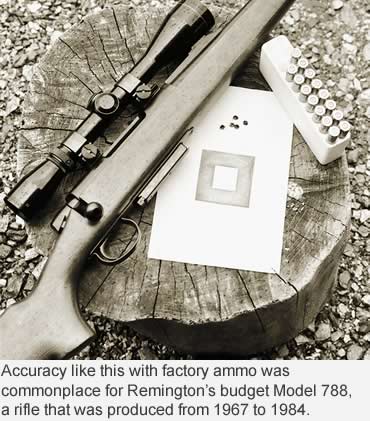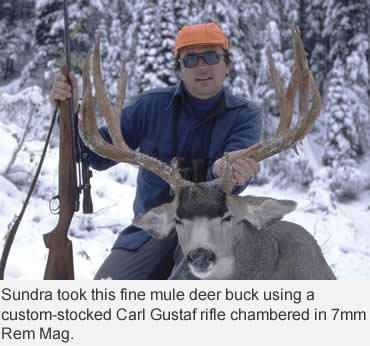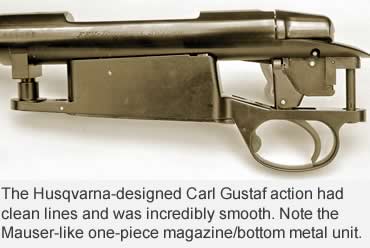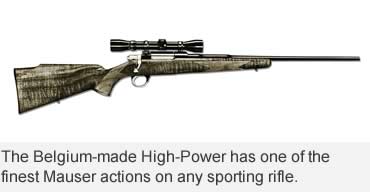By Jon R. Sundra
These hunting guns are no longer made, but are well worth seeking on the used gun market.
Photo: Top: Winchester Model 9422. Center: Remington Nylon 66. The Nylon 66’s unique construction and looks were far ahead of its time. It remains the best-selling rimfire rifle in the history of Remington Arms. Bottom: Remington Model 788.
Over the years, we’ve seen a lot of new guns introduced, every one of them touted as the latest and greatest. Some really were and went on to achieve success and longevity, but most proved to be little more than minor variations of existing designs.
Unfortunately, all guns have a limited lifespan in what can be a fickle marketplace, and often their success or failure has nothing to do with their merits.
I’m sure most hunters can come up with at least a couple of discontinued guns they’d love to have a second chance at owning. It’s a subjective thing, of course, but I can almost reflexively think of five outstanding models that are well worth seeking on the used gun market.
Winchester’s Model 9422 — Produced from 1972 to 2005, this is the finest lever-action .22 rimfire ever made, in my opinion. When the 9422 was introduced, Winchester was trying to recover from its decision made almost a decade earlier to cheapen its guns, most notably the Model 70. So when I first heard the company would be unveiling a lever-action rimfire rifle in the tradition of its iconic Model 94 centerfire, I was skeptical.
All doubts vanished when I saw this rifle for the first time. It was absolutely superb. The machining, the wood-to-metal fit, the lustrous blue and the effortless way the action cycled was on a quality level I never expected.
Its performance matched its appearance. Eventually, after more than one shake-up in management and corporate philosophy, the company once again began producing the quality guns on which they had built their reputation, but it was the 9422 that set the tone for that transformation.
The 9422 was offered in both .22 Long Rifle and .22 Magnum (WMR) and, if memory serves, retailed initially at $99.95. That was pretty expensive for a .22 rimfire back then, but oh what a bargain it was!
Over its 33-year production span, it was offered in more than a dozen iterations ranging from a standard grade with walnut stock, WinCam and WinTuff laminates, Legacy, Trapper and XTR Classic versions, to 25th Anniversary editions and commemoratives. The latter are collectors’ items, but all the other models make superb working guns.
Fortunately, the 9422 has not been out of production long, so they are not at all hard to find on the used gun market, and it’s not that unusual to find examples in absolute mint condition or even brand new. If you already own one, consider yourself fortunate.
 Remington’s Nylon 66 — When introduced in January 1959, words like radical, revolutionary, innovative and futuristic were just some of the adjectives used to describe what was to become the most successful rimfire rifle in the history of Remington Arms. By the time production ceased in 1991, more than 1 million had been produced. Nothing even remotely similar to the Nylon 66 had ever been seen before or since.
Remington’s Nylon 66 — When introduced in January 1959, words like radical, revolutionary, innovative and futuristic were just some of the adjectives used to describe what was to become the most successful rimfire rifle in the history of Remington Arms. By the time production ceased in 1991, more than 1 million had been produced. Nothing even remotely similar to the Nylon 66 had ever been seen before or since.
Although this gun’s physical appearance alone warranted the aforementioned descriptions, its basic design and the components that comprised it were just as radical.
For one thing, other than having a bolt, firing pin, mainspring and magazine tube of steel, the rest of the gun was made of Zytel 101, an injection-molded polymer developed by DuPont (which owned Remington at the time). The material was stable enough to retain tight tolerances under all reasonable temperature extremes, had high-impact, structural and flexural strength, was impervious to solvents, acids and fungi, was self-lubricating and permanently held colors.
What looks like a more or less conventional steel receiver like those found on Remington’s semiauto and slide-action centerfire rifles is nothing more than a sheet metal cowling that slips over the real receiver, which is an integral part of the two-piece stock. By two-piece, I mean the stock consists of two halves split vertically, which are bonded together.
Since there was no receiver per se, the barrel simply sat in a V-block molded into the stock and held in place with a bracket. Loosening one screw allows the barrel to be pulled free of the stock for easy cleaning from the breech end.
The Nylon 66 was such a departure from convention that Remington spent nearly four years of research and testing before releasing the gun, and it proved to be well worth it.
The same year the gun was introduced, Remington field rep Tom Frye set a record for both endurance and marksmanship that has yet to be broken.
Using three Nylon 66s shooting at 2 1/2-inch-square wooden blocks thrown into the air, Frye missed only six of 100,010 blocks! This remarkable feat had him shooting 8 hours a day for 13 days! A picture of him sitting atop a mountain of the wood blocks was used in an ad promoting the Nylon 66.
The gun was originally offered in two stock colors: Mohawk brown and Seneca green. The former proved to be the most popular by far, and the latter was discontinued in 1962. Other versions over the years included the Apache Black and a Bicentennial Commemorative.
This radical-looking yet handsome rifle has long since achieved iconic status. I wish I had hung onto at least one of the several that passed through my hands for test and evaluation over the years.
 Remington’s Model 788 — Manufactured from 1967 to 1984, this bolt-action centerfire rifle was introduced as a budget alternative to the Model 700. Consider that the least expensive Model 700, the ADL, had a retail price of $134.95 in 1967, while the new 788 could be had for $84.95. That’s a big difference.
Remington’s Model 788 — Manufactured from 1967 to 1984, this bolt-action centerfire rifle was introduced as a budget alternative to the Model 700. Consider that the least expensive Model 700, the ADL, had a retail price of $134.95 in 1967, while the new 788 could be had for $84.95. That’s a big difference.
If ever there was a plain Jane looking rifle, this was it. The receiver was a simple thick-walled tube with a minimal size ejection port. No machining or grinding of facets was done to give relief or visual interest; it was a pipe, plain and simple.
The stock was equally vanilla-like in that it was essentially a plainer uncheckered version of the 700 ADL’s stock in a figureless walnut.
The trigger guard was stamped sheet steel, as was the detachable single-row magazine. The iron sights provided were not up to 700 standards, and the rear sight was mounted on a plastic quarter rib. So much for the gun’s visual appeal.
What made the 788 different from all other rifles of the day was that it was built on a multi-lug, rear-locking action. Three rows of three locking lugs — nine in all — were oriented on 120-degree centers and situated just ahead of the bolt handle. Bolt rotation, i.e. handle lift, was only 68 degrees instead of the usual 90 required for twin lug actions.
My reason for including it here as a gun worthy of acquiring is because it was so accurate, embarrassingly so for Remington. The 788 usually outshot the company’s flagship Model 700s! Its thick tube of a receiver with a minimal ejection port was much stiffer than conventional receivers. That attribute translated into tiny little groups.
Over the course of its 17-year life-span, the 788 was offered in nine calibers: .222 Rem, .22-250, .243, 6mm Rem, 7mm-08, .308 Win, .30-30 and .44 Magnum. From 1972 to 1979, a left-hand version was made.
Several of these guns also passed through my hands, and all but one were returned after T&E. I bought one in 7mm-08, but let someone talk me into selling or trading it — I can’t recall which. In retrospect, it was a really dumb move.
 Carl Gustaf — When this rifle was introduced on these shores in 1969, it was known as the Husqvarna Model 9000. As its designation indicates, the action was designed by Husqvarna in Sweden, which prior to that was manufacturing a commercial Model `98 Mauser that was fully equal in quality to the FN Supreme actions made in Belgium for Browning.
Carl Gustaf — When this rifle was introduced on these shores in 1969, it was known as the Husqvarna Model 9000. As its designation indicates, the action was designed by Husqvarna in Sweden, which prior to that was manufacturing a commercial Model `98 Mauser that was fully equal in quality to the FN Supreme actions made in Belgium for Browning.
Shortly after the new action was put into production, Husqvarna’s firearms division was purchased by FFV, Sweden’s national armaments conglomerate. Military contracts were drying up at the time, and the company had to find work to comply with that nation’s cradle-to-grave employment policies.
For a short time, the gun was imported and sold by Smith & Wesson as the Model 9000 Crown Grade, but then FFV decided to establish a subsidiary company here to market the gun themselves. That’s when the name of the gun was changed to Carl Gustaf in honor of Sweden’s kings. But that, too, was short lived, and in the mid-1970s, Stoeger became the new importer and marketer of the gun under the same Carl Gustaf name. Again, that was for a brief time. By the end of the `70’s, the gun was no longer being imported.
During the few short years this gun was available here — under whatever name — it just may have been the smoothest bolt-action rifle on the planet. It was a twin-lug, Mauser-type action, but what made it unique and so slick in its operation was its dovetail shape locking lugs. These engaged similar-shaped raceways in the receiver to provide lateral bolt support that straight-walled lugs cannot.
It was also one of the cleanest actions in that there was no external bolt stop/release, and the shroud at the rear of the bolt was beautifully streamlined. Cosmetically, it was one of the most beautiful actions ever designed.
Though I’m getting tired of saying it, several Carl Gustaf rifles passed through my hands without my keeping even one. I did, however, get the opportunity to hunt with a couple of them. One chambered in 7mm Rem Magnum I used to take my best mule deer to date.
The Carl Gustaf was styled, finished and priced at about the same level as a contemporary Weatherby Mark V.
 Browning High Power — This rifle requires little introduction or description by me, but that doesn’t make it any less worthy of inclusion here. Although Browning marketed other guns under the same High Power name, the ones I’m talking about are the rifles based on the FN Supreme action made in Belgium for Browning from 1959 to 1974.
Browning High Power — This rifle requires little introduction or description by me, but that doesn’t make it any less worthy of inclusion here. Although Browning marketed other guns under the same High Power name, the ones I’m talking about are the rifles based on the FN Supreme action made in Belgium for Browning from 1959 to 1974.
There were many variations and grades of these guns, but the one thing they had in common was that they were built around what is probably the finest example of a commercial Mauser ever made.
By commercial, I mean that except for the elimination of the thumb slot on the left side of the receiver, and the replacement of the military shroud-mounted wing safety with a commercial trigger and a streamlined bolt shroud, we’re talking pure military ’98 Mauser to the point of virtual part interchangeability.
As one who appreciates the genius of Paul Mauser’s contribution to the evolution of firearms design, I regret that I have never acquired one of what is the finest example of the commercial equivalent thereof.
In fact, I wish I had the foresight to keep just one of the five guns discussed here. Talk about missed opportunities!
Read Recent GunHunter Articles:
• Stock Options: Got an inaccurate rifle? Maybe it’s time for a different handle.
• America’s Most Popular OU: A very high-quality shotgun for the price, the Browning Citori holds up to extensive shooting.
This article was first printed in the July 2011 edition of Buckmasters GunHunter Magazine. Subscribe today to have GunHunter delivered to your home.